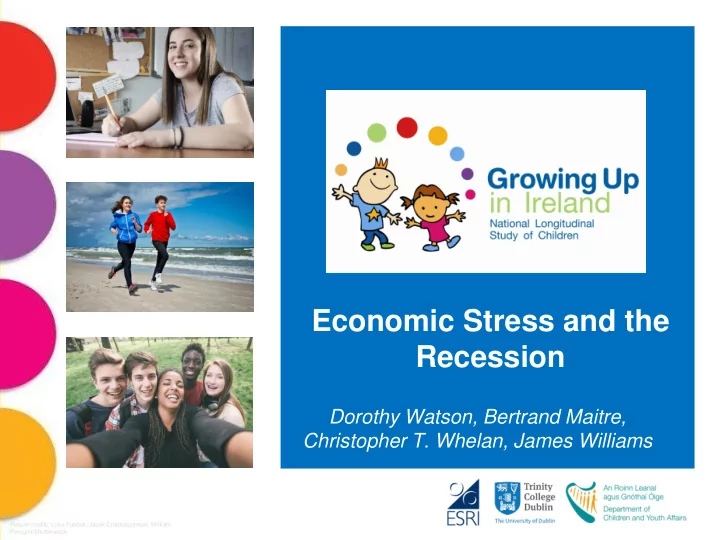

Economic Stress and the Recession Dorothy Watson, Bertrand Maitre, Christopher T. Whelan, James Williams Picture credits: Luka Funduk; Jacek Chabraszewski; William Perugini/Shutterstock
Background • Debate over ‘who suffered most’ in the recession ( Whelan, Nolan & Maître, 2016a, O’Connor & Staunton, 2016, Social Justice Ireland, 2016; Whelan & Nolan, forthcoming). – polarisation of inequality – equal impact on all groups or – ‘squeezed middle’ • We draw on two waves of GUI data to investigate family experience of financial stress
Outline • The recession – timing and GUI 1998 cohort • Methodology • Descriptive analysis • Model Results • Conclusion
Timing of GUI 1998 cohort surveys 16 136 9 years 15 132 14 128 wave 1 13 124 12 120 11 116 10 112 13 years 9 108 wave 2 8 104 7 100 6 96 5 92 4 88 3 84 2 80 2007 Q1 2007 Q2 2007 Q3 2007 Q4 2008 Q1 2008 Q2 2008 Q3 2008 Q4 2009 Q1 2009 Q2 2009 Q3 2009 Q4 2010 Q1 2010 Q2 2010 Q3 2010 Q4 2011 Q1 2011 Q2 2011 Q3 2011 Q4 2012 Q1 2012 Q2 2012 Q3 2012 Q4 Unemployment (%, Left hand axis) Child benefit, per child (2007=100) One Parent Family with 1 child (2007=100)
Methodology • GUI data longitudinal sample of 1998 cohort (age 9 & age 13) • Social class – European Socio-economic Classification (ESeC) – Higher professional/managerial – Lower professional managerial – Intermediate (clerical, technicians) and self-employed – Lower services, sales; skilled and semi-skilled manual – Routine (unskilled) manual and service • Family Type (Couple with 1-2 children; couple with 3+ children, lone parent) • Economic stress: ‘great difficulty’ or ‘difficulty’ in making ends meet.
Descriptive results Family type & social class (w1) Change in economic stress 0% 5% 10% 15% 20% 25% 30% 35% 40% 45% 50% 30% Hi Prof/ manag. 17% 23% Social Class 25% Lo Prof/ manag 27% 18% 20% … Intermed. /tech 19% 15% … Lo services, 22% 8% 10% 5% Routine etc. 16% 3% 5% Family type Lone parent 18% 0% … 36% Couple, 1-2 … 46% Couple, 3+
Economic stress by Family Type 50% Pre-recession (Risk %, Composition %) 40%, 30% Recession (Risk %, Composition %) 40% +18% But 21%, 42% 30% X 1.8 18%, 27% + 14% 20% but X 4.7 22%, 50% 10% 0% 4%, 17% 6%, 33% -10% Couple, 1-2 children Couple, 3+ children Lone Parent
Economic stress by social class 60% Pre-recession (Risk %, Composition %) Recession (Risk %, Composition %) 40%, 28% 50% +6% 30%, 28% 40% +21% but but X 6 20%, 16% 30% X 2 17%, 20% 12%, 8% 20% 10% 19%, 39% 10%, 28% 7%, 16% 0% 4%, 13% 2%, 4% Hi profess/ Lo profess/ Intermed./ Lo service/ Routine 0.5 1.5 2.5 3.5 4.5 5.5 -10% manag. manag. tech/ SE sales etc. etc.
Model of Economic Stress (odds ratios) Interaction Main effect with wave 2 Family W1 Lone parent 3.84*** 0.51** (Ref: couple, 1-2) Couple, 3+ children 1.27 Class W1 (Ref: Hi Lo profess./manag. 1.45 profess./man) Intermed. /tech/SE 1.90 Lo service etc. 2.68*** Routine etc. 3.59*** Income W1 Lowest 8.97*** 0.35*** (Ref: Highest) Q2 4.88*** 0.46* Q3 2.68** Wave (Ref: Boom) Recession 15.68***
Conclusions • Polarisation? – Supported if look at absolute increase in stress by group: greater percentage point increase for more disadvantaged groups – But if viewed in relative terms, we see a reduction in inequalities • General Impact? Shift in the profile of economically stressed families – more couple families and higher social class families than in W1 • Squeezed middle? Middle and higher classes were not immune from the impact of the recession – They experienced a level of stress that was new to them – Social protection system provided an important safety net to vulnerable families, narrowing the class and family type gaps
Recommend
More recommend